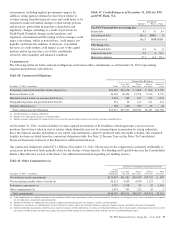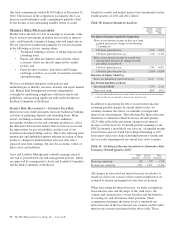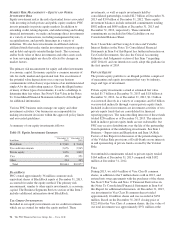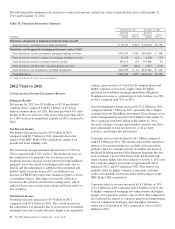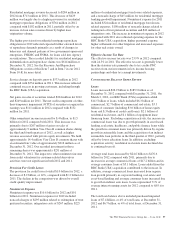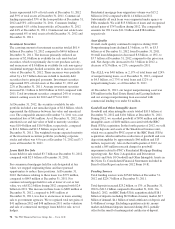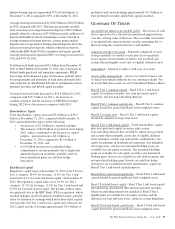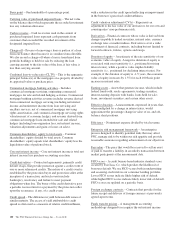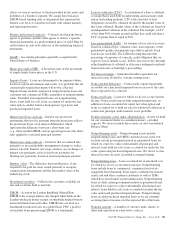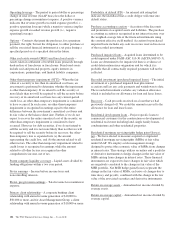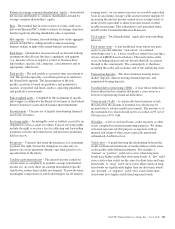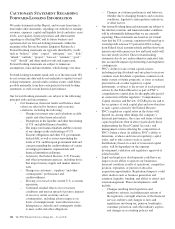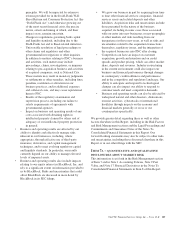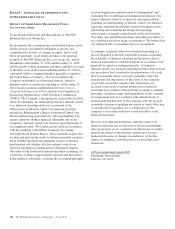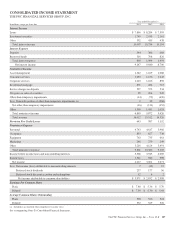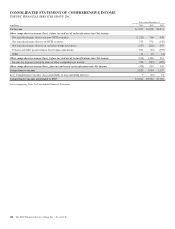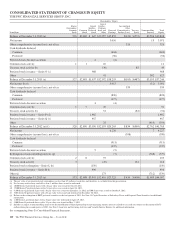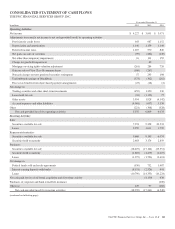PNC Bank 2013 Annual Report Download - page 119
Download and view the complete annual report
Please find page 119 of the 2013 PNC Bank annual report below. You can navigate through the pages in the report by either clicking on the pages listed below, or by using the keyword search tool below to find specific information within the annual report.
effects of sources and uses of funds provided by the assets and
liabilities of a business segment. We assign these balances
LIBOR-based funding rates at origination that represent the
interest cost for us to raise/invest funds with similar maturity
and repricing structures.
Futures and forward contracts – Contracts in which the buyer
agrees to purchase and the seller agrees to deliver a specific
financial instrument at a predetermined price or yield. May be
settled either in cash or by delivery of the underlying financial
instrument.
GAAP – Accounting principles generally accepted in the
United States of America.
Home price index (HPI) – A broad measure of the movement
of single-family house prices in the U.S.
Impaired loans – Loans are determined to be impaired when,
based on current information and events, it is probable that all
contractually required payments will not be collected.
Impaired loans include commercial nonperforming loans and
consumer and commercial TDRs, regardless of nonperforming
status. Excluded from impaired loans are nonperforming
leases, loans held for sale, loans accounted for under the fair
value option, smaller balance homogenous type loans and
purchased impaired loans.
Interest rate floors and caps – Interest rate protection
instruments that involve payment from the protection seller to
the protection buyer of an interest differential, which
represents the difference between a short-term rate
(e.g., three-month LIBOR) and an agreed-upon rate (the strike
rate) applied to a notional principal amount.
Interest rate swap contracts – Contracts that are entered into
primarily as an asset/liability management strategy to reduce
interest rate risk. Interest rate swap contracts are exchanges of
interest rate payments, such as fixed-rate payments for
floating-rate payments, based on notional principal amounts.
Intrinsic value – The difference between the price, if any,
required to be paid for stock issued pursuant to an equity
compensation arrangement and the fair market value of the
underlying stock.
Investment securities – Collectively, securities available for
sale and securities held to maturity.
LIBOR – Acronym for London InterBank Offered Rate.
LIBOR is the average interest rate charged when banks in the
London wholesale money market (or interbank market) borrow
unsecured funds from each other. LIBOR rates are used as a
benchmark for interest rates on a global basis. PNC’s product
set includes loans priced using LIBOR as a benchmark.
Loan-to-value ratio (LTV) – A calculation of a loan’s collateral
coverage that is used both in underwriting and assessing credit
risk in our lending portfolio. LTV is the sum total of loan
obligations secured by collateral divided by the market value of
that same collateral. Market values of the collateral are based on
an independent valuation of the collateral. For example, a LTV
of less than 90% is better secured and has less credit risk than a
LTV of greater than or equal to 90%.
Loss given default (LGD) – An estimate of loss, net of recovery
based on collateral type, collateral value, loan exposure, or the
guarantor(s) quality and guaranty type (full or partial). Each
loan has its own LGD. The LGD risk rating measures the
percentage of exposure of a specific credit obligation that we
expect to lose if default occurs. LGD is net of recovery, through
either liquidation of collateral or deficiency judgments rendered
from foreclosure or bankruptcy proceedings.
Net interest margin – Annualized taxable-equivalent net
interest income divided by average earning assets.
Nonaccretable difference – Contractually required payments
receivable on a purchased impaired loan in excess of the cash
flows expected to be collected.
Nonaccrual loans – Loans for which we do not accrue interest
income. Nonaccrual loans include nonperforming loans, in
addition to loans accounted for under fair value option and
loans accounted for as held for sale for which full collection of
contractual principal and/or interest is not probable.
Nondiscretionary assets under administration – Assets we hold
for our customers/clients in a nondiscretionary, custodial
capacity. We do not include these assets on our Consolidated
Balance Sheet.
Nonperforming assets – Nonperforming assets include
nonperforming loans and OREO and foreclosed assets, but
exclude certain government insured or guaranteed loans for
which we expect to collect substantially all principal and
interest, loans held for sale, loans accounted for under the fair
value option and purchased impaired loans. We do not accrue
interest income on assets classified as nonperforming.
Nonperforming loans – Loans accounted for at amortized cost
for which we do not accrue interest income. Nonperforming
loans include loans to commercial, commercial real estate,
equipment lease financing, home equity, residential real estate,
credit card and other consumer customers as well as TDRs
which have not returned to performing status. Nonperforming
loans exclude certain government insured or guaranteed loans
for which we expect to collect substantially all principal and
interest, loans held for sale, loans accounted for under the fair
value option and purchased impaired loans. Nonperforming
loans exclude purchased impaired loans as we are currently
accreting interest income over the expected life of the loans.
Notional amount – A number of currency units, shares, or
other units specified in a derivative contract.
The PNC Financial Services Group, Inc. – Form 10-K 101


